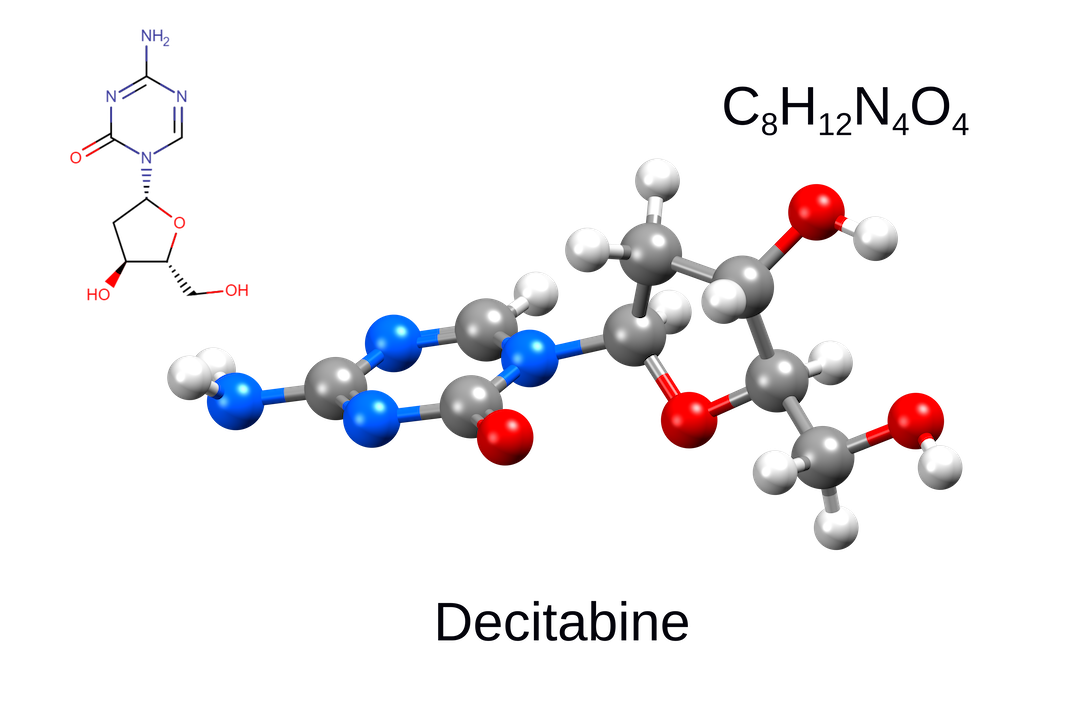News
Article
Decitabine, Venetoclax Combo Boosts Survival in Patients With AML and MDS
Author(s):
Study findings demonstrate that combining decitabine with venetoclax enhances molecular response rates in patients with acute myeloid leukemia (AML) and myelodysplastic syndromes (MDS), correlating strongly with improved clinical outcomes and overall survival.
Combination therapy with decitabine and venetoclax significantly improves molecular clearance and overall survival (OS) in patients with acute myeloid leukemia (AML) and myelodysplastic syndromes (MDS), while also demonstrating that these molecular responses were consistent between sample types, according to a recent study published in Haematologica.1
The researchers analyzed treatment outcomes of 95 patients with AML or MDS who were treated at either Washington University or MD Anderson Cancer Center. The first cohort received a 10-day treatment cycle with decitabine alone (n = 64),2,3 and the second cohort received decitabine and venetoclax (n = 31).4,5 The findings reveal that the combination therapy facilitated a more rapid and deeper molecular clearance of the disease compared with decitabine alone.
In this present analysis, 64 patients received decitabine alone | Image Credit: Walter_D-stock.adobe.com

"We found that both the rate and depth of mutation clearance correlated with clinical responses and with overall survival and that molecular results correlated between bone marrow and peripheral blood samples," the authors summarized.
Patients were selected based on the availability of serial samples and prior genomic sequencing data. The cohorts were enriched for MDS or secondary AML cases to evaluate whether mutations could still be detectable in peripheral blood, even in cytopenic conditions.
The study used serial exome sequencing completed over 2014 through 2019 to quantify the patients' molecular responses. Linear regression models were used to evaluate the rate of clearance of founding clone mutations. The rate of founding clone reduction was calculated based on the time points representing the induction of treatment and the first maximal reduction in variant allele frequency. Somatic mutation calling was standardized across all samples using established pipelines, and subclonal mutation organization was manually curated for each patient.
Thirty-one patients received decitabine and venetoclax | Image Credit: molekuul.be-stock.adobe.com

The researchers also examined patients with specific genetic mutations, such as a TP53, that traditionally predict poor outcomes. When comparing the rate of founding clone reduction based on recurrent myeloid mutations, TP53-associated cases exhibited an increased rate of founding clone clearance and prolonged OS within the decitabine-alone cohort, compared with mutations in other genes, which is consistent with previous reports. In the decitabine-venetoclax cohort, IDH1/2 and NRAS-associated cases exhibited an increased rate of founding clone clearance and OS compared with TP53-mutant cases. OS between the 2 treatment cohorts was similar.
The researchers point out that the cohorts were not clinically well balanced. The patients who received decitabine alone was enriched for patients who had MDS, de novoAML, and better performance status, with trends toward less adverse risk karyotypes. Based on study preferences at the time, the initial decitabine-venetoclax cohort had been enriched for relapsed and refractory cases.
The study findings also highlight a significant correlation between molecular results obtained from bone marrow and peripheral blood analyses, with the results showing that founding clonal reduction appeared largely preserved in peripheral blood vs bone marrow samples. These results suggest that less invasive blood sampling could potentially serve as a reliable surrogate for bone marrow in monitoring disease response.
Successful AML clinical trials have historically been challenging, requiring large numbers of patients. The authors concluded that, "These observations support the future use of molecular end points as adjuncts in clinical trials and raise the question of whether clonal clearance might be a sufficiently early and independent median-based measure of anti-leukemic activity to successfully identify promising new regimens using smaller cohorts."
References
1. Gruszczynska A, Maiti A, Miller C, et al. Molecular response in decitabine- and decitabine/venetoclax-treated patients with acute myeloid leukemia and myelodysplastic syndromes. Haematologica. Published online April 11, 2024. doi:10.3324/haematol.2022.281396
2. DiNardo CD, Maiti A, Rausch CR, et al. 10-day decitabine with venetoclax for newly diagnosed intensive chemotherapy ineligible, and relapsed or refractory acute myeloid leukaemia: a single-centre, phase 2 trial. Lancet Haematol. 2020;7(10):e724-e736.
3. Genomic predictors of decitabine response in patients with acute myeloid leukemia or myelodysplastic syndromes. ClinicalTrials.gov. Updated October 2, 2018. Accessed May 16, 2024. https://clinicaltrials.gov/study/NCT01687400
4. Kim K, Maiti A, Loghavi S, et al. Outcomes of TP53-mutant acute myeloid leukemia with decitabine and venetoclax. Cancer. 2021;127(20):3772-3781.
5. Venetoclax and decitabine in treating participants with relapsed/refractory acute myeloid leukemia or relapsed high-risk myelodysplastic syndrome. ClinicalTrials.gov. Updated January 5, 2024. Accessed May 16, 2024. https://clinicaltrials.gov/study/NCT03404193





